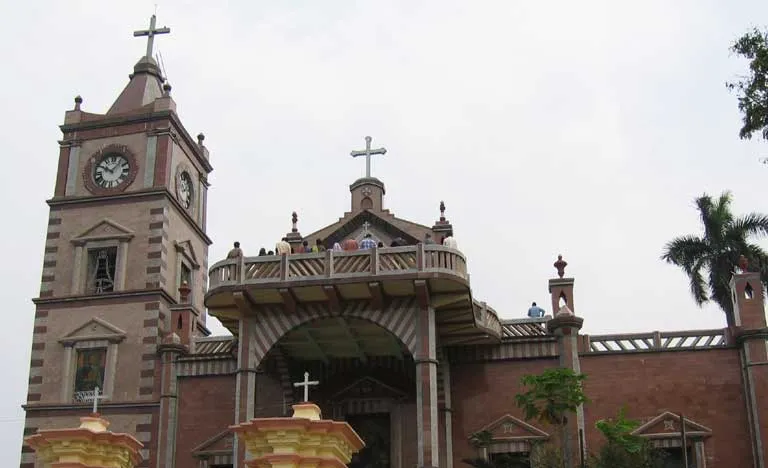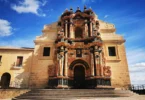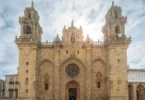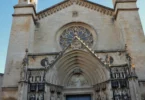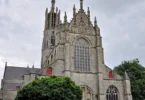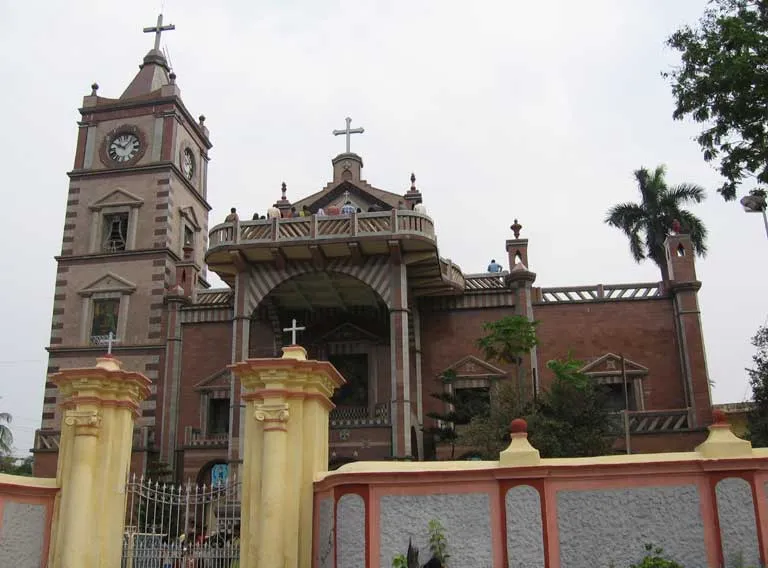
Introduction
Basilica of Our Lady of the Rosary, Bandel, West Bengal, India popularly known as Bandel Church & Basilica of the Holy Rosary. The sanctuary built in 1599 and declared a Basilica on November 24, 1988 by John Paul II, is endowed with a sacred shrine at the balcony devoted to Our Lady of Happy Voyage.
Basilica of Our Lady of the Rosary, Bandel – First and Old Catholic church in Bengal!
The Rosary is a Prayer of Hope – Symbolic of the Roman Catholic veneration of Mother Mary. It comprises of 5 sets of 10 “Hail Mary” interspersed with “Our Father” prayers. In the year 1214 AD, Saint Dominic was handed over the Rosary by an apparition of the Blessed Virgin Mary. This apparition is called as Our Lady of the Rosary – signifying ‘garland of Roses’.
It was when the Portuguese began using Bandel as a port in the sixteenth century that they were given permission by the Mughal Emperor Akbar to build a town in Hooghly. It was around this time that the priests began to baptize the natives and soon the Catholics in Hooghly numbered around five thousand.
The Augustinian Friars who were the largest religious body in Goa were enlisted by the Portuguese and soon the Emperor’s permission was obtained to preach the Catholic faith to the public. The time was ripe to build a church at Bandel, in the year 1599.
This first church of Bandel was burnt down by the Moors in 1632. As history reveals, Emperor Shah Jehan attacked and destroyed the Portuguese settlements including the church. Four out of the five priests were killed and lone Father Joan da Cruz survived. When Tiago, an ardent devotee of Mother Mary tried to carry her statue across the river to safety, he was killed by an enemy arrow. The statue sank into the river.
When Father da Cruz was captured along with other devotees and condemned to die by stampede of wild elephants by the then Emperor Shah Jehan, a miracle occurred. The elephant stood in front of the priest and lifted him aloft with his trunk and placed him on his back. He also knelt before the Emperor with the priest on his back and asked for mercy. This miracle impressed the Emperor so much that he set the prisoners and Father Cruz free.
It was after the miracle that Shah Jehan changed his mind and donated about 101.21 hectares to the local Christians, and a new church was constructed by Gomez de Soto in the year 1660 over the ruins. The keystone foundation of the ancient church remains in the eastern gate of this beautiful church.
History of Basilica of Our Lady of the Rosary, Bandel

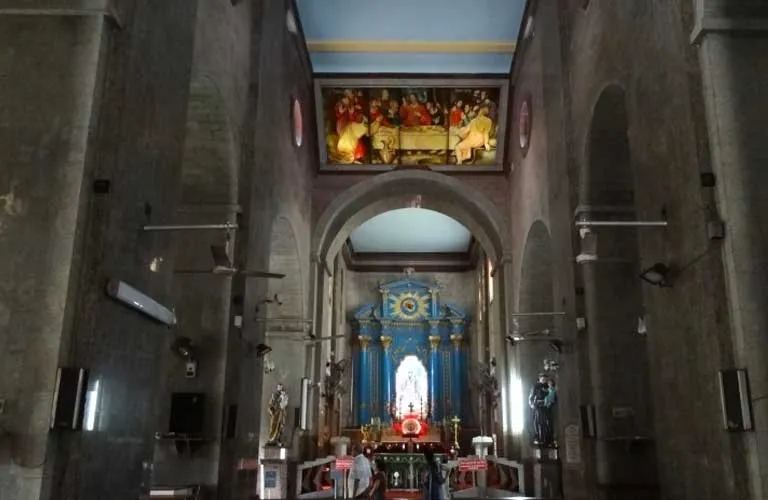
The story of Basilica of Our Lady of the Rosary, Bandel begins with the first Portuguese settlements in Bengal. Most historians agree that in 1537, an Admiral, Sampovo, entered the River Hoogly with nine Portuguese vessels to support Mahmud Shah, the Pathan Nawab of Gaurav, who being hard pressed by the famous Sher Khan, had asked the Portuguese representatives in Goa for assistance. As a reward for their efforts, the Nawab allowed the Portuguese to set up a factory at a spot close to the present Hooghly jail. In 1579 the Portuguese constructed a port on the bank of the river Hoogly. It became a centre of trade and commerce.
To protect their interests they built a fort. They soon secured the services of a small band of Augustinian Friars, then the largest religious body in Goa. About the year 1580 a certain Captain Pedro Tavares, a great favourite of the Moghul Emperor Akbar, obtained from him full liberty to preach the Christian faith publicly and to erect churches. In 1599, a monastery was established at Bandel, a village about a mile from the factory. In a short time, two other churches were built within the limits of the factory – a military chapel was added to the fort and an alms-house under the title of Santa Casada Misericordia which provided help to the poor, and was also used as a school.
Persecution of the Christians
About the year 1622, Prince Harun, afterwards Emperor Shah Jahan, revolted against his father Jehangir and asked the Portuguese Governor at Hooghly, Michael Rodrigues, to help him with men and artillery which he refused.
Shah Jahan who ascended the throne in 1628, ordered the Moghul Subedar of Bengal to exterminate the Portuguese. The Subedar laid siege to the fort. But the Jarge Moghul army was no match to the two hundred well trained Portuguese and their plentiful supply of ammunition. Finally, however, the Portuguese were betrayed by one of their own officers.
On 24th June 1632, feast of St. John the Baptist, while everyone was in Church attending a religious service, the enemy were given secret entrance to the fort, they set on fire the arsenal, took possession of all the arms and blew up the fortifications. The panic-stricken people were massacred without mercy. The Governor was captured and burnt alive, and over four thousand men, women and children were made prisoners and carried off to Agra, the then capital of the Moghul Empire. All the Churches and other public buildings were razed to the ground. The only place that escaped major damage was the monastery at Bandel.
Of the five Augustinian Friars made captive, only one aged priest, Father Joao da Cruz, was spared. The brave priest, and all the Christians were taken to far away Agra to be thrown to the wild beasts.
The Triumph of the Christians
A grand Durbar was arranged, and a vast arena prepared. Huge crowds flocked to Agra, to witness this extraordinary spectacle. Four savage, famished, wild elephants made a dash at the Christians. But their fury vanished and they grew calm. The biggest elephant approached Fr. Da Cruz, caught him by its trunk, and set him on its back. Then with the priest still on its back, it approached the Emperor, knelt down before him, and bowing its head, saluted him with its trunk.
The crowd considered this a divine intervention. They shouted that Christians were friends of Allah and should be set free.
Shah Jahan sent Fr. Joao da Cruz back to Bandel commissioning him to rebuild the mission. The Emperor presented him with 777 bighas of land in the village of Bandel around the monastery by a ‘Firman’ which also listed seventeen privileges to govern the community. He also exempted them from Moghul interference and taxation and they were to be directly under the Emperor. The Firman conceded by Shah Jahan guided the destinies of Bandel for many years. In fact, in days gone by, the Prior of Bandel was like a petty governor, collecting rent, administering justice and even having a police force of his own.
Fr. Da Cruz and the Christians on returning to Bandel began immediately to rebuild the church from the ruins of the old one.
Christian Community Rebuilt
By the middle of the 17th century, the Christian Community around Bandel numbered nearly 10,000. Bandel again became a little commercial centre, but it never reached its former greatness as the biggest port in the Moghul Empire.
Fr. Joao da Cruz who had become too old and feeble handed over the Shrine to the newly arrived Augustinians from Goa. His superior advised him to leave Bengal and go to Goa where he died in June or July 1638, and was buried in the church of Nossa Senhora da Graca.
Pope John Paul II – In Everlasting Remembrance
The widely renowned and deeply venerated Shrine to the Most Blessed Virgin Mary of the Holy Rosary is the oldest Church in the region of North India. It was erected in Bengal, India, in the sixteenth century by missionaries hailing from Diocese of Mylapore. This Church passed through various disturbances of the times and under changes in sacred art, so that in time is was beautified and thus became an attraction for the furtherance of piety among the faithful of the Archdiocese of Calcutta.
It, therefore, appeared clear to Our Venerable Brother Henry Sebastian D’Souza, that nothing was lacking to this sacred historical monument to be honoured with the title of Minor Basilica. To this effect he petitioned the Apostolic See to have this favour granted. Being fully aware of how greatly this privilege can promote the piety and fervour of the clergy and faithful, we have been pleased to accede to this petition of the Archbishop.
Therefore after consulting the Sacred Congregation for Divine Worship, by our Aposotolic Authority and in virtue of this decree, We declare the Church dedicated to the Blessed Virgin Mary of the Most Holy Rosary at Bandel in the Archdiocese of Calcutta to be raised to the dignity of Minor Basilica with all relevant rights and privileges in accordance with the sacred canons, strictly adhering however to everything laid down in the decree, Concerning the Title of Minor Basilica’, published on 6th June 1968. Given at Rome, at the See of St. Peter, marked with the Seal of the Fisherman, this 25th day of November 1988, the eleventh year of Our Pontificate.
Bandel Church Today

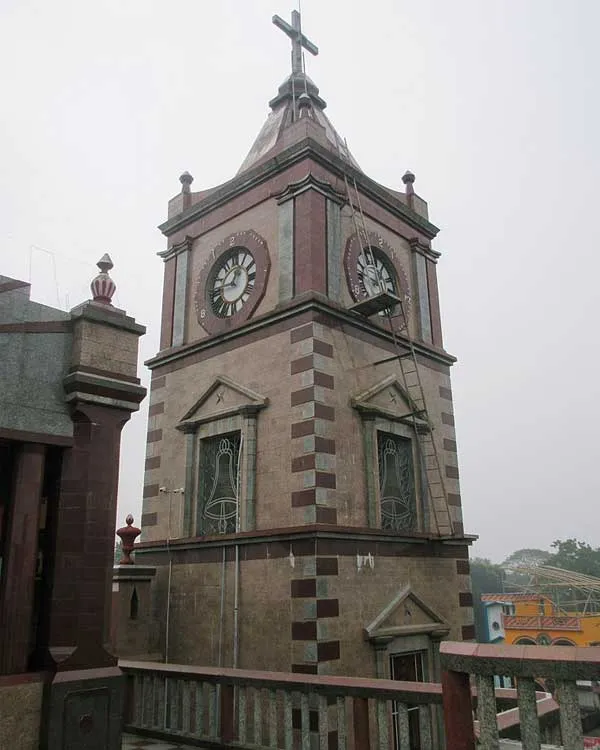
In 1928 Bandel Church and the monastery were entrusted to the Salesians of Don Bosco. Attached to the Church there is a Minor Seminary, three High Schools, a Centre for Spiritual Retreats and a boarding for village girls.
The coming of the Salesians in 1928 marked the end of the “Padroado” (dependence on the king of Portugal and the Diocese of Mylapore). The Salesian Society handed over by formal document to Mylapore Diocese, the Don Bosco Press and Mission at Tanjur (Tamil Nadu) in exchange for Bandel Shrine, structures and lands. Thousands of people of all faiths visit the Church. On Christmas and the New Year their number swells to many thousands.
The Statue of Our Lady of Happy Voyage (Our Lady of Bandel)

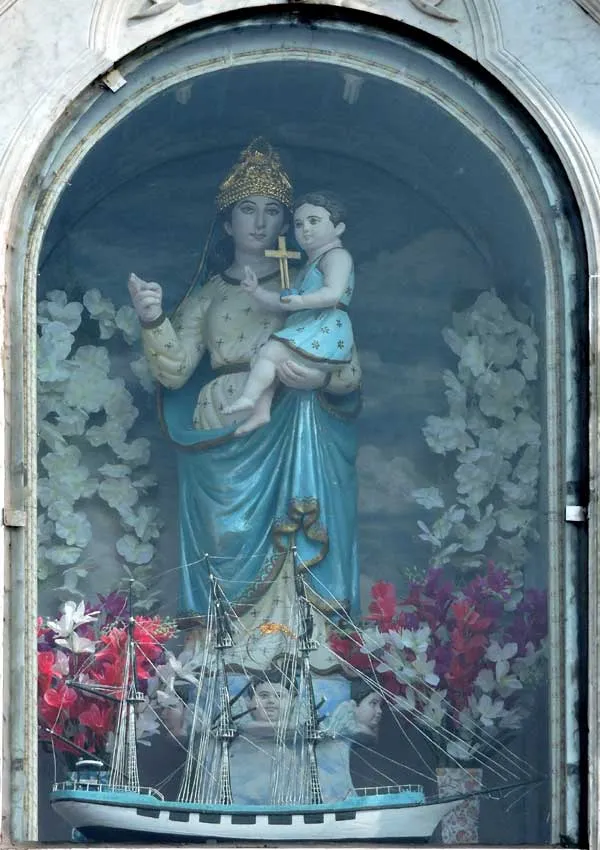
Sometime during the middle of the 16th century, Bandel, presently an urban area within the Chinsurah subdivision of Hooghly district in the Indian state of West Bengal, began to be used by the Portuguese as a port. In the latter 1500’s, permission was granted by Mughal Emperor, Akbar, to create a town in Hooghly. As the town began to grow, Augustinian Friars, the largest religious order in Goa began catechizing and baptizing the local natives. By the end of the 16th century, there were nearly five thousand Catholics in Hooghly.
The centre of attraction at Bandel Church is the Statue of Our Lady of Happy voyage high up in the niche on the topmost part of the facade. Originally this statue was on the altar of the military chapel attached to the Portuguese factory which was destroyed in 1632 during the siege of Hooghly. During the capture of Hooghly one merchant, Tiago, tried to take the statue safely to the other side of the river.
But, struck by arrows, he disappeared with the statue in the water. During one stormy night after the return of the Christians from Agra, while the rebuilding of the church was going on, Fr.da Cruz saw a strange light on the river bank and heard a voice like that of his old merchant friend Tiago calling him, “Hail, hail, hail to Our Lady of Happy Voyage who has given us victory. Arise, arise, O Father, and pray for us all.”
The story of Our Lady of Bandel, also known as Our Lady of Happy Voyage has an interesting back story that consists of a priest who heard a voice and faithful ship captain. Within the heart of the Basilica of Bandel, which is dedicated to Our Lady of the Rosary, stands the statue of Our Lady of Happy Voyage.
The first story begins with a siege of a Portuguese military chapel that was attacked during the battle of Hooghly by the Moors. A faithful Catholic merchant who loved the Blessed Mother tried to take the statue to a safe place on the other side of the river, but was shot by arrows. He and the statue disappeared under the water. The Moors murdered all of the priests, however, one priest miraculously survived – Fr. Joan Da Cruz.
During a story night sometime later after the Christians returned to the area, Fr. Da Cruz was standing on the river bank and heard a voice, which sounded like the merchant who took the statue for safe keeping. The voice said, “Hail, hail, hail, to Our Lady of Happy Voyage who has given us victory. Arise, arise, O father and pray for us all.” The following morning some villagers were seen near the church yelling, “Guru Ma!” (the Blessed Mother) has returned.
In complete shock, Fr. Da Cruz located the once missing statue of the Blessed Virgin only a few yards from the gate of the church. He took the statue and placed it on the main altar and to commemorate the event instituted a feast during which the statue is carried in procession. In the year 1910, the statue was moved to ‘the balcony of the Church.
The other story is about a faithful ship captain who encountered a massive storm in the Bay of Bengal. With the ship nearly destroyed, the captain asked for the intercession of the Blessed Mother, who rescued the ship. Now a ship’s mast is in front of the church to remind the faithful of that miracle, which was the captain’s vow if he was saved and lived through the storm.
During the month of November, thousands of faithful Catholics from India travel to the Basilica of Bandel to thank Our Lady of the Rosary and to honor the miracles. The Bandel Church, raised to a Basilica in 1988 by Pope St. John Paul II.
The Mast: A Captain’s Votive Offering
While the celebrations for the blessing of the rebuilt Church were in progress a large Portuguese ship appeared on the river bank. The ship had encountered a terrific storm in the Bay of Bengal; the Captain, a deeply religious man, had made a vow to the Blessed Virgin in thanksgiving for being saved from a shipwreck: he had one mast of his vessel removed and presented to the church. He had it fixed in the ground in front of the church where it still stands.
Relic of the Blessed Virgin Mary
It will come as a surprise to many to know that Bandel Church Possesses a Relic of the Blessed Virgin Mary. The Relic, a piece of the veil of the Blessed Virgin Mary, enclosed in a brass case of an oval shape, and encircled by rubies, was in the centre of an old silver cross of artistic workmanship. While handling the old articles of Bandel Church, the original document in Latin, dated the 2nd February 1791, and signed by the Apostolic Nuncio at Lisbon, was found in good condition, authenticating the relic.
His Lordship the Bishop of Mylapore in 1919 examined the original document, and authorized the exposition of the Relic for veneration.
The Intentions Letter Boxes
A moving tradition has been established at Bandel Shrine through the centuries: writing messages to Our Lady, praying to Our Lady, praying for graces or expressing gratitude for favours received. Ascending the stairs to the Balcony of the Basilica at the left of the statue of Our Lady of Happy Voyage, the ‘Intention Box’ is placed, similar to the safe for offerings on the right side. A replica of these two safety-boxes is to be found within the Basilica, opposite the baptismal font, for those who cannot go up the staircase to the roof and the balcony. Here the relic from the veil of Our Lady is exposed.
The messages written by the faithful are collected and burnt on the 24th of each month before the Grotto of Lourdes in the Monastery Garden, while the Mothers of the Confraternity of Our Lady Help of Christians pray the Rosary, chant hymns and light candles. Often in these letters one single expression is written: Dear Mother, I love you!
Offering Votive Candles
Devotion to Our Lady is also expressed in a grand way by offering and lighting votive candles of various sizes and colour at all altars and statues of the Shrine. Candles go on burning all through the day.
Blessings and Holy Water
The Prior and the Priests of the Shrine are called to bless pilgrims and families at all times. These devout visitors are happy to take home blessings from the Shrine. Holy Water, blest in the Shrine, is taken home in bottles or sprinkled on the sick or used for simple blessings. All understand that petition and thanksgiving letters, Candles, Holy Water signify devotion and express a deep love to the Blessed Virgin Mary.
Feast Day – On November
Bandel Basilica was born with the name of Church of the Holy Rosary. That name remains till the present day. The second title of Our Lady of Happy Voyage came to exist when her icon wonderfully re-appeared from the waters of the river Hooghly in which it had gone down during the siege of Hooghly by the Mughals in the year 1632. It is a statue that had journeyed from Portugal over high seas and oceans; finally it landed as a gift from the crew of a ship. Mysteriously the statue was found on the banks of the river in front of the Church.
The feast of the Holy Rosary is celebrated at Bandel for the past four hundred years in the month of November. Posters and Programmes of this feast are preserved in the archives of the Basilica. The icon of Mary is being carried in procession along the streets, the gardens and the grounds of the Church.
The universal feast of the Holy Rosary in the Catholic Church was instituted by Pope St. Pius V in 1571, when a great naval battle in which hundreds of ships were employed was fought and won in the defence of Christiandom, on the seas of Lepanto, South of Greece. Besides the name of the Holy Rosary, it was also called the Feast of the Holy Mary of Victories, acknowledging the protection to the Catholic Church by Mary in many battles, heresies, plagues and natural calamities.
At the time of St. Pius V, the Holy Mary of Victories was with Christian Armies, fighting real battles with weapons to save Christendom, but today she fights for the Church, to overcome the forces of the evil. The Rosary is the real spiritual weapon, holy and strong, against error, ignorance, fanaticism, and intolerance. In the Middle Ages, Our Lady of the Holy Rosary inspired heroism to armed forces in battles, today she assists the messengers of the Lord who evangelise the nations. She teaches how to proceed with humility, obedience to God, and service in love, as she did at the Annunciation.
In the History of Bandel Church we read the narration of battles and houses of mercy. Around the Basilica educational and charitable institutions, homes for the homeless and other services have been established by her inspiration.
Mass Time
Weekdays
First Friday & All Saturdays
Sundays
Contact Info
Basilica of Our Lady of the Rosary,
Bandel, Hooghly Dist.,
West Bengal 712 103, India
Phone No.
Tel : 033 – 26312206
Accommodations
Connectivity
Basilica of Our Lady of the Rosary, Bandel, West Bengal, India is well connected with Bus Station, Railway Station and Airport facilities rest of the country.
Airways
Netaji Subhash Chandra Bose Airport, Kolkata, West Bengal which is (54 Kms) from Basilica of Our Lady of the Rosary Bandel.
Railways
The nearest railway station Bandel Railway Station which is (2.1 Kms) and Howrah Railway Station is (51.3 Kms) from Basilica of Our Lady of the Rosary Bandel.
Roadways
The nearest is Bandel, Mini Bus Terminal which is (2.5 Kms) from Basilica of Our Lady of the Rosary Bandel.

